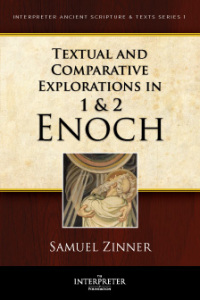 [The following review was written by Allen Hansen.]
[The following review was written by Allen Hansen.]
If you are looking for something that discusses the parallels between ancient Enoch texts and the Book of Moses, then Samuel Zinner’s book might not be for you. It is not Nibley’s Enoch the Prophet. Zinner, who is not a member, does not even discuss Joseph Smith and the Restoration until the final chapter. Instead, what Zinner has given us is a very erudite exploration of the two groups of text known as 1 and 2 Enoch. He is conversant with current scholarship on a variety of topics, and is a pleasure to read.
In the past, Zinner has produced sensitive translations of Anna Akhmatova and Osip Mandelstam, two of the most elegant and powerful voices in Russian poetry. I’ve dabbled in translating Russian poetry just for fun, so I can speak to how difficult an undertaking it is. Translation requires not only a grasp of the bigger picture, but also of the incidental details, and how the words paint images. These are important skills to have when dealing with ancient texts which are often cryptic and confusing. Zinner is well-prepared to dig deep into these texts.
The chapters are generally fairly short. The topics cover a variety of issues. There is discussion of the meaning of the phrases “Son of Man,” and “Ancient of Days,” the relationship between 1 Enoch and the Book of Daniel, Gnosticism, Iranian religions, Mandaeism, the Quran, and medieval Jewish mysticism. There are plenty of charts showing the parallels being discussed, and despite this book primarily consisting of textual studies, no languages other than English are required in order to enjoy it. When foreign terms are used, they are always rendered in English as well, so non-specialists will benefit.
One of the highlights for me is the chapter discussing a parallel between 2 Enoch and the writings of Rabbi Isaac of Acre, a highly important transmitter of Enochic lore. I’ve presented a paper co-authored with Walker Wright on a different teaching of Rabbi Isaac’s on Enoch’s love for God, so it was nice to encounter the somewhat obscure rabbi in this context. Zinner suggests that Rabbi Isaac’s teaching on how God revealed to Enoch that sacrifice unites God and man (or superior and inferior worlds) is ultimately derived from 2 Enoch. This illustrates just how far-reaching of an impact ancient texts can have, even when they are not explicitly mentioned in medieval writings.
I don’t find all of Zinner’s logical steps persuasive, but even then he often suggests brilliant solutions. A good case in point is the chapter dealing with a curious term in 2 Enoch- “their clothing was various singing.” Zinner presents a Mandaean parallel to demonstrate that ‘foaming’- a variant reading preserved in a Bulgarian manuscript- should be preferred to the standard rendition ‘singing.’ Zinner then shows how it A minor detail? 2 Enoch is full of odd and uncertain readings. The minor details can make or break our understanding of the book’s message. Zinner is not the only scholar to look to Mandaean texts. Nathaniel Deutsch, for example, has successfully shed light on puzzling passages in Jewish mystical texts by drawing upon Mandaean insights and concepts. Mandaeism is among the only living religions engaging in ritualized ascents of the soul, and has a long textual history, so its importance for studying things like 1 and 2 Enoch is obvious.
Zinner’s speculation over deluge traditions, or which book preceded which, does not materially affect the conclusion in this case. Zinner is not afraid to go out on a limb, so the results are frequently illuminating. This book is less a compendium of definitive answers, and more of an intelligent discussion partner sounding out various possibilities and inviting us to dig deeper. This opens the door to further questions and research.
Chapter 19, dealing with some Latter-day scriptures, is the most speculative. I personally find it the weakest, too. Zinner looks at the concept of Zion in Joseph Smith’s revelations and connects it to Lady Wisdom and Asherah, seeing Zion as a divine hypostasis.
Despite my reservations, Zinner raises some very important points in this chapter. He very pertinently observes that Joseph Smith’s prophecies of Zion are “simultaneous[ly] temporal-eternal,” pointing to a teaching of the Zohar on how the world to come is not just a future event, but is present now, too. One needn’t accept the Zohar as the genuine teachings of Rabbi Shimeon bar Yohai in order to appreciate how useful of a concept this can be for understanding Joseph’s revelations. It might seem odd to some readers that Zinner insists upon reading God’s wings in 1 Enoch seriously, given how central an anthropomorphic god is to our teachings. Zinner, though, has a point. I found the quoted Arapaho Ghost Dance song particularly moving. It helps move past simplistic dichotomies such as literal versus symbolic/allegorical. 1 Enoch, after all, is not a Mormon text.
Because this book has been published by Interpreter, I hope that this will whet the appetite of LDS readers for closer engagement with the riches to be found in these kinds of sources.
Forget what I said at the beginning. If you have an interest in ancient and medieval texts and thought, as well as possible affinities with our scripture and doctrine, this book is for you. Zinner is worth hearing out. The Interpreter Foundation is to be commended for publishing such an intriguing work by a non-LDS author.
